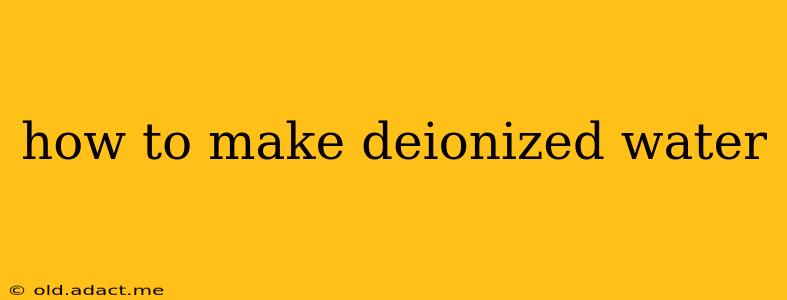Deionized water (DI water), also known as demineralized water, is water that has had almost all of its mineral ions removed. This process significantly reduces the water's total dissolved solids (TDS), making it ideal for various applications where impurities can be problematic, such as in laboratories, car batteries, and steam irons. While you can purchase DI water, understanding how it's made can be valuable, and for certain low-volume needs, you might even consider making your own. This guide explores the methods and considerations involved.
What is Deionization?
Deionization is a water purification process that removes ions from water using ion exchange resins. These resins are typically composed of small beads that contain charged functional groups. These groups attract and bind to oppositely charged ions in the water, effectively removing them. The process involves two types of resins:
-
Cation exchange resin: This resin contains negatively charged functional groups that attract and bind positively charged ions (cations) like calcium (Ca²⁺), magnesium (Mg²⁺), and sodium (Na⁺).
-
Anion exchange resin: This resin contains positively charged functional groups that attract and bind negatively charged ions (anions) like chloride (Cl⁻), sulfate (SO₄²⁻), and bicarbonate (HCO₃⁻).
Methods for Making Deionized Water
Creating deionized water at home isn't practical for large quantities, but for small-scale needs, you can explore these options:
1. Using a Deionization Filter System (DIY Approach)
This is the most common method for producing DI water, though requires specialized equipment. You'll need:
- A container: To hold the water.
- A deionization filter: This is a cartridge containing the ion-exchange resins. These cartridges are readily available online and in some scientific supply stores.
- Appropriate tubing and fittings: To connect the filter cartridge and container.
Process:
- Prepare the container: Ensure it's clean and free of contaminants.
- Install the filter cartridge: Follow the manufacturer's instructions for connecting the cartridge to the container.
- Fill the container with tap water: Don't overfill.
- Allow the water to pass through the filter: The filtered water will collect in your container.
- Monitor the output: Observe the filter’s performance. A reduction in flow rate indicates resin exhaustion.
Important Considerations: The effectiveness and longevity of your DIY system depend on the quality of the resin and the initial water quality. Tap water with high mineral content will exhaust the resin faster. This method is suitable only for small-scale applications.
2. Using Commercially Available DI Water Systems
For larger quantities or more consistent results, consider using a dedicated deionization system. These systems come in various sizes and capacities and are designed for continuous operation. They often incorporate features like conductivity monitoring to indicate the quality of the produced water. This is a more costly solution compared to the DIY method.
Frequently Asked Questions (PAAs)
What are the uses of deionized water?
Deionized water is used in various applications where impurities can interfere with processes or products. Common uses include:
- Scientific laboratories: For experiments and analyses to prevent contamination.
- Automotive industry: For car batteries and cooling systems.
- Industrial processes: For cleaning, rinsing, and various manufacturing processes.
- Steam irons: To prevent mineral buildup and damage.
Is deionized water safe to drink?
While deionized water doesn't contain harmful minerals, it's not recommended for regular consumption. It lacks essential minerals and can even leach minerals from the body. Therefore, it's best used for non-potable applications.
How do I know when my deionization filter needs replacing?
The most common indicators are a significant decrease in water flow rate and a change in the conductivity (measured using a conductivity meter). The manufacturer's instructions should also specify the filter's expected lifespan.
What is the difference between distilled water and deionized water?
Both are purified water types, but the purification methods differ. Distillation removes impurities through boiling and condensation, while deionization specifically removes ions using ion exchange resins. Distillation may not remove all dissolved non-volatile compounds, while deionization might leave behind some very small organic molecules.
Can I reuse the ion exchange resin?
In most cases, no. Once the resin is exhausted (its capacity to remove ions is depleted), it's generally not cost-effective to regenerate it. Replacing the resin is usually the more practical option.
This guide provides a comprehensive overview of making deionized water. Remember to always prioritize safety and follow instructions carefully when handling any water purification system. For large-scale needs, consulting with a water purification specialist is recommended.
